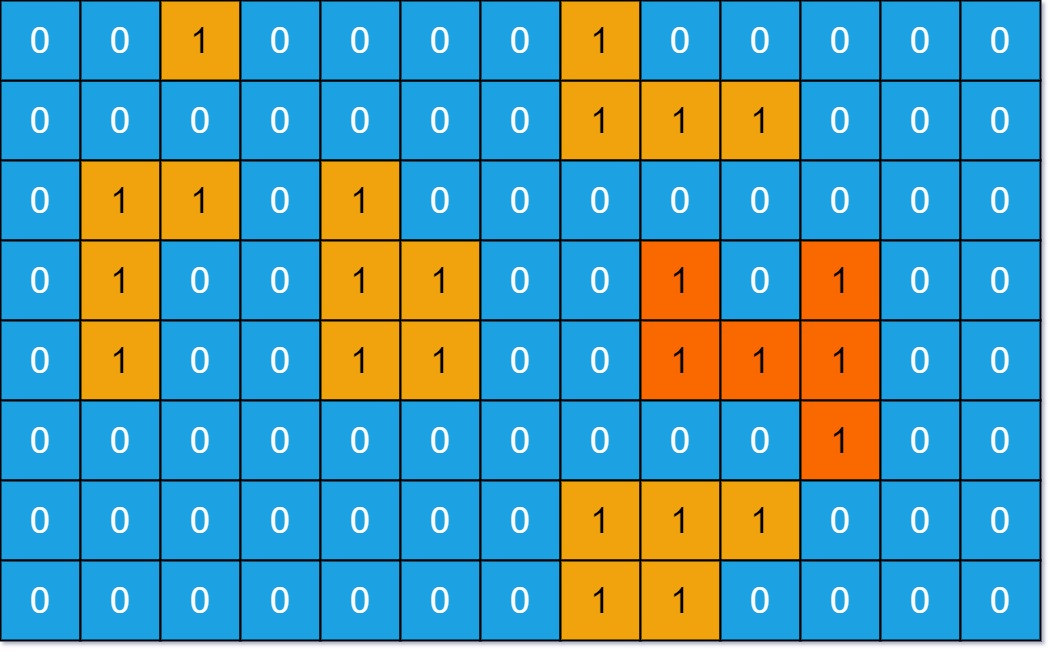695. Max Area of Island
Question
You are given an m x n binary matrix grid. An island is a group of 1's (representing land) connected 4-directionally (horizontal or vertical.) You may assume all four edges of the grid are surrounded by water.
The area of an island is the number of cells with a value 1 in the island.
Return the maximum area of an island in grid. If there is no island, return 0.

Example 1:
Input: grid = [[0,0,1,0,0,0,0,1,0,0,0,0,0],[0,0,0,0,0,0,0,1,1,1,0,0,0],[0,1,1,0,1,0,0,0,0,0,0,0,0],[0,1,0,0,1,1,0,0,1,0,1,0,0],[0,1,0,0,1,1,0,0,1,1,1,0,0],[0,0,0,0,0,0,0,0,0,0,1,0,0],[0,0,0,0,0,0,0,1,1,1,0,0,0],[0,0,0,0,0,0,0,1,1,0,0,0,0]]
Output: 6
Explanation: The answer is not 11, because the island must be connected 4-directonally.
Example 2:
Input: grid = [[0,0,0,0,0,0,0,0]]
Output: 0
Constraints:
- m == grid.length
- n == grid[i].length
- 1 <= m, n <= 50
- grid[i][j] is either 0 or 1.
Approach
Recursive
- Create a boolean vector with the same size as
grid, this will be used when we iterate through cells. - For each cell in the
grid, we check the total area that is interconnected. - If the cell is
0, area is simply 0. Mark the cell as checked in the boolean vector. - Otherwise, increment the total area by checking, if any, the left / right / top / bottom cells of the current cell, and mark them as well.
- E.g. If the left cell of current cell has a neighbour, we will check that as well and increment the area. Rinse and repeat.
- Stop when all the neighbours of cells that are
1are marked as check. - Return the maximum area after checking the whole grid.
Solution
class Solution {
public:
int maxAreaOfIsland(vector<vector<int>>& grid) {
//empty grid to record flag
vector<vector<bool>> flag(grid.size(),vector<bool> (grid[0].size()));
int maxArea = 0;
for(int i = 0; i < grid.size(); i++){
for(int j = 0; j < grid[0].size(); j++){
maxArea = max(maxArea,checkCells(grid,flag,i,j));
}
}
return maxArea;
}
int checkCells(vector<vector<int>>& grid, vector<vector<bool>>& flag,int i, int j){
if(flag[i][j]) return 0;
else flag[i][j] = true;
int area = 0;
if(grid[i][j] > 0) area = 1;
else return 0;
//left
if(i > 0) area += checkCells(grid,flag,i - 1,j);
//right
if(i < grid.size() - 1) area += checkCells(grid,flag,i + 1,j);
//up
if(j > 0) area += checkCells(grid,flag,i,j - 1);
//down
if(j < grid[0].size() - 1) area += checkCells(grid,flag,i,j + 1);
return area;
}
};